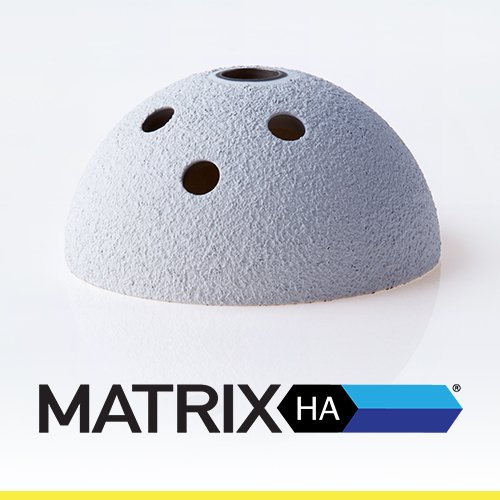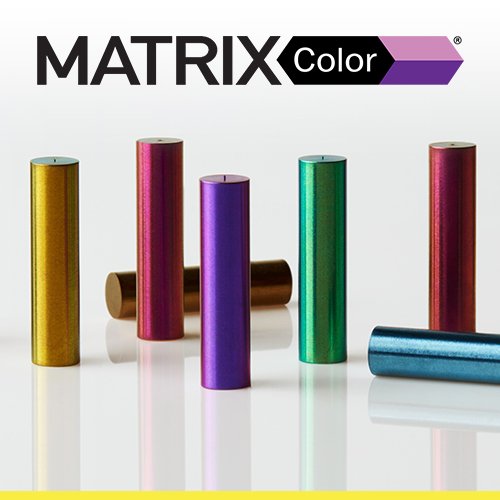Exacting Biocompatible Micro Abrasive Blasting Without Residual Contaminants
Grit-blasting with Himed’s MCD apatitic abrasive creates a virtually residue-free, textured surface on titanium and Ti-alloy medical devices. Orthopedic and dental implants require such surfaces to either increase the surface area that comes in contact with the bone, or as a surface preparation prior to the application of a coating such as hydroxyapatite or titanium.
Where conventional abrasive blasting techniques utilizing alumina or silicon carbide leave residual abrasive as a contaminant, Himed’s MATRIX MCD® is a biocompatible solution that leaves no such contaminants after ASTM F86 passivation, resulting in a cleaner textured surface.
MATRIX MCD® uses Himed’s proprietary multi-phase calcium phosphate (MCD) abrasive, which is manufactured to be just hard enough to add a uniform texture on Ti and Ti-alloy surfaces without compromising the dimensional accuracy of an implant’s design.
MATRIX MCD® Attributes
Highly uniform macro & micro surface texturing
Custom masking options for all implant surfaces
Free of alumina and silicon carbide contaminants
Surface roughness range (RA) of 1.0–3.2 micrometers
Surface Roughness Promotes Implant Osseointegration
Decades of research have shown that the surface roughness (Ra) of an implantable titanium device can positively impact the natural factors for osteogenesis due to an increase in the total bone-to-implant contact area. That’s why dental and orthopedic device manufacturers around the world work with Himed to optimize an application of MATRIX MCD® that will support improved osseointegration of their implants.
While there are chemical methods for achieving a textured surface on titanium, Himed’s MATRIX MCD® is a purely mechanical modification wherein bioresorbable apatitic grit is sprayed at high velocity against the implant surface to achieve the desired level of texture. Multiple parameters can be adjusted, such as particle size and spray distance, to allow for a fully customizable surface treatment suited to a specific implant’s design.
Our fully-automated blast system allows for even, exacting, and reproducible results that can be easily scaled to high volume lots.
Master Device File MAF1239 Volume II and III have been established at the US Food and Drug Administration (FDA) for MATRIX MCD®
Volume II – Apatitic Calcium Phosphate Grit Blasting Of Dental And Orthopedic Implants
Volume III – Manufacturing Of Calcium Phosphate Grit (MCD) For Grit Blasting Of Dental And Orthopedic
Implants
Successive magnifications of a conventionally milled titanium dental implant using scanning electron microscopy (SEM) demonstrate the textured surface of pure titanium that results from MATRIX MCD® post-processing following passivation.
MATRIX MCD® Works with Other Surface Enhancements
Medical devices are highly complex products that often require very specific surface characterization to achieve their intended functionality.
While MATRIX MCD® can stand alone as a final post-processing treatment for a wide variety of implants, Himed can also combine applications of medical-grade anodized color, hydroxyapatite, or even a thicker layer of titanium, to a surface that has received MATRIX MCD®.
COMBINE MATRIX MCD® WITH THESE ADDITIONAL SURFACES
Apatitic Abrasive vs Conventional Grit When Post-Processing Titanium Medical Devices
Abrasive blasting is often used as a post-processing technique on titanium medical implants to remove surface imperfections that can result from the manufacturing process. In addition to creating a more unified surface appearance, a lightly textured surface can be advantageous over a more polished surface because increased porosity improves bioactivity—encouraging critical bone repair processes to occur organically around the implant.
While there are a couple of industry-accepted grit blast media used for the surface texturing of titanium medical devices, only Himed’s MATRIX MCD® offers a solution that avoids adding embedded contaminants to the device surface. Just look at the two SEM magnification comparisons below…
RESULTS OF ALUMINUM OXIDE GRIT BLASING
SEM imagery of a 3d-printed Ti64 spinal spacer following abrasive blasting with aluminum oxide grit. Note the dark colored areas across the surface—these are representative of abrasive material embedded in the Ti surface during application.
RESULTS OF MATRIX MCD® APATITIC ABRASIVE BLASTING
SEM sequence demonstrating the post-passivation results of a MATRIX MCD® application of <53μm apatitic abrasive. Particle size impacts the relative smoothness of the refined surface, with larger MCD of 425–180μm yielding a rougher surface topography.
Want to see a more detailed review of these post-processing comparisons, additional SEM imagery, and EDX spot analysis data? SEE THE COMPLETE COMPARISON HERE >
GET THE MATRIX MCD® White Paper
MATRIX MCD® can be applied as a post-processing technique for titanium medical devices produced by traditional metallurgical manufacturing processes, but it can also be an ideal post-processing technique for devices produced via additive manufacturing.
Over three different case studies, this white paper demonstrates why MATRIX MCD® offers unparalleled post-processing options for 3D-printed devices.







